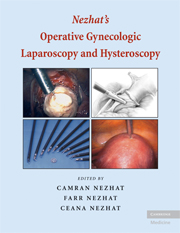Book contents
- Frontmatter
- Contents
- Contributing Authors
- Forewords
- Preface
- 1 HISTORY OF MODERN OPERATIVE LAPAROSCOPY
- 2 EQUIPMENT
- 3 ANESTHESIA
- 4 LAPAROSCOPIC ACCESS
- 5 LAPAROSCOPIC SUTURING
- 6 INTRAPERITONEAL AND RETROPERITONEAL ANATOMY
- 7 FERTILITY
- 8 HYSTEROSCOPY
- 9 MANAGEMENT OF ADNEXAL MASSES
- 10 ENDOMETRIOSIS
- 11 LAPAROSCOPIC ADHESIOLYSIS AND ADHESION PREVENTION
- 12 LEIOMYOMAS
- 13 HYSTERECTOMY
- 14 PELVIC FLOOR
- 15 LAPAROSCOPIC TREATMENT OF CHRONIC PELVIC PAIN
- 16 GYNECOLOGIC MALIGNANCY
- 17 LAPAROSCOPY IN THE PREGNANT PATIENT
- 18 MINIMAL ACCESS PEDIATRIC SURGERY
- 19 LAPAROSCOPIC VASCULAR SURGERY IN 2007
- 20 COMPLICATIONS IN LAPAROSCOPY
- 21 ADDITIONAL PROCEDURES FOR PELVIC SURGEONS
- 22 LAPAROSCOPY SIMULATORS FOR TRAINING BASIC SURGICAL SKILLS, TASKS, AND PROCEDURES
- 23 ROBOT-ASSISTED LAPAROSCOPY
- 24 HYSTEROSCOPY AND ENDOMETRIAL CANCER
- 25 OVERVIEW OF COMPLICATIONS
- Appendix
- Atlas
- Index
11 - LAPAROSCOPIC ADHESIOLYSIS AND ADHESION PREVENTION
Published online by Cambridge University Press: 23 December 2009
- Frontmatter
- Contents
- Contributing Authors
- Forewords
- Preface
- 1 HISTORY OF MODERN OPERATIVE LAPAROSCOPY
- 2 EQUIPMENT
- 3 ANESTHESIA
- 4 LAPAROSCOPIC ACCESS
- 5 LAPAROSCOPIC SUTURING
- 6 INTRAPERITONEAL AND RETROPERITONEAL ANATOMY
- 7 FERTILITY
- 8 HYSTEROSCOPY
- 9 MANAGEMENT OF ADNEXAL MASSES
- 10 ENDOMETRIOSIS
- 11 LAPAROSCOPIC ADHESIOLYSIS AND ADHESION PREVENTION
- 12 LEIOMYOMAS
- 13 HYSTERECTOMY
- 14 PELVIC FLOOR
- 15 LAPAROSCOPIC TREATMENT OF CHRONIC PELVIC PAIN
- 16 GYNECOLOGIC MALIGNANCY
- 17 LAPAROSCOPY IN THE PREGNANT PATIENT
- 18 MINIMAL ACCESS PEDIATRIC SURGERY
- 19 LAPAROSCOPIC VASCULAR SURGERY IN 2007
- 20 COMPLICATIONS IN LAPAROSCOPY
- 21 ADDITIONAL PROCEDURES FOR PELVIC SURGEONS
- 22 LAPAROSCOPY SIMULATORS FOR TRAINING BASIC SURGICAL SKILLS, TASKS, AND PROCEDURES
- 23 ROBOT-ASSISTED LAPAROSCOPY
- 24 HYSTEROSCOPY AND ENDOMETRIAL CANCER
- 25 OVERVIEW OF COMPLICATIONS
- Appendix
- Atlas
- Index
Summary
Adhesions are defined as connections between opposing serosal and/or nonserosal surfaces of the internal organs and the abdominal wall, at sites where there should be no connection. This connection can be a band, which is vascular or avascular, and filmy/transparent or dense/opaque, or it could be a cohesive connection of surfaces without an intervening adhesion band. Adhesion formation is an almost unavoidable consequence of abdominal surgery. Although not all patients with intra-abdominal adhesions develop symptoms, the clinical implications, such as early and late bowel obstruction, infertility, and chronic abdominal pain, remain a common problem in general surgical and gynecologic practice. In addition, adhesion formation is associated with increased socioeconomic costs.
THE RISK FACTORS AND CLINICAL SIGNIFICANCE OF ADHESIONS
The risk factors for pelvic adhesions include a history of pelvic inflammatory disease (PID), prior surgery, perforated appendix, endometriosis, and inflammatory bowel diseases. Other recognized causes of adhesions include bacterial peritonitis, radiotherapy, chemical peritonitis, foreign body reaction, long-term continuous ambulatory peritoneal dialysis, endometriosis, and pelvic inflammatory disease. However, the greatest contribution of these risk factors is a previous history of an intra-abdominal operative procedure.
Adhesion formation after abdominal and pelvic operations remains extremely common and is a source of considerable morbidity. Menzies and Ellis confirmed that after an intra-abdominal operation, most patients developed adhesions.
- Type
- Chapter
- Information
- Nezhat's Operative Gynecologic Laparoscopy and Hysteroscopy , pp. 304 - 315Publisher: Cambridge University PressPrint publication year: 2008



